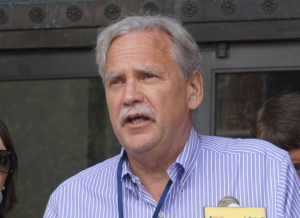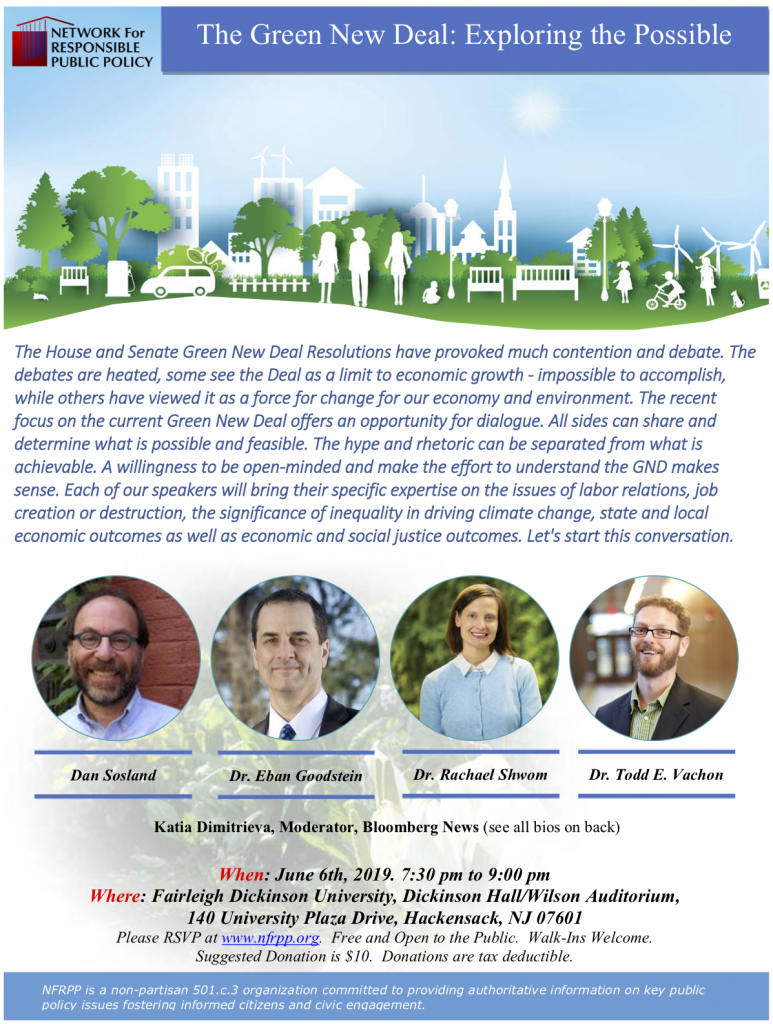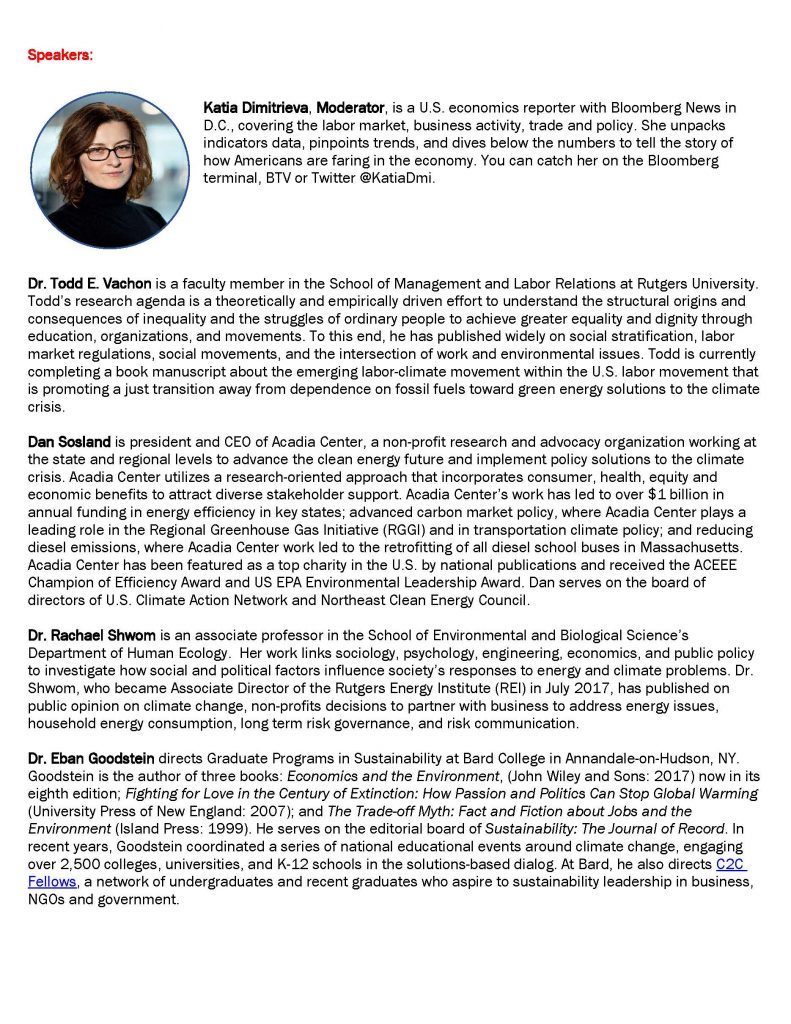
(This is an expanded version of what I sent to the NJBPU yesterday to meet their deadline for officially commenting on the 2019 Draft EMP.)
Background
I have either testified and/or sent the NJBPU comments on various editions of the EMP over the years. And, as an assignment, one of my classes once sent them comments, too. This will be the final time.
I have been involved in energy issues, on-&-off-&-on, in different roles as a Sustainability Change-Agent in New Jersey, for over 40 years. I:
• Was a marketing manager/researcher for energy processing equipment for seven years at Western Electric/AT&T
• Worked with the NJBPU and it was a member of the Interagency Sustainable State Work Group I managed at the New Jersey Department of Environmental Protection (NJDEP). NJBPU speakers gave a few talks at a seminar series I co-ran there. I also co-catalyzed NJDEP’s initial climate change efforts
• Attended BPU conferences
• Was on a BPU Education committee
• Worked on energy issues as a volunteer with two environmental groups
• Taught two semesters of Energy Policy at a Ramapo College, arranged with the then-NJBPU President to have some departmental guest speakers at the class, and facilitated three energy panels at a conference at the college, including a plenary with her
• Gave and facilitated talks and wrote articles (see below) on climate change in New Jersey
• Was a Senior Fellow at Fairleigh Dickinson University’s Institute for Sustainable Enterprise for 12 years
• Am a perpetual student, currently pursuing a Ph.D. in sustainability at Erasmus University in the Netherlands, focusing on Sustainable Transformational Change.
Introduction
To some degree I’m comforted that New Jersey now recognizes the climate change problem, its urgency, and that State Government, environmental groups and other non-profits, academics, and some journalists have begun serious efforts to address it. This had not been the case. Therefore, it’s not a bad time to leave this turf, but that doesn’t mean the NJBPU is not still missing parts of key elements of what will likely be necessary.
I understand and applaud the NJBPU for asking for guidance on 28 specific questions, but this time I cannot deeply sort through those needs. I hope they are getting sufficient input from others. Still, it should be helpful in thinking about their Question 11: “What policy, legislative, or regulatory mechanisms can New Jersey develop to ensure that it can most cost-effectively pursue a 100% carbon neutral power sector?;” the three questions which are part of “Strategy 7: Expand the Clean Energy Innovation Economy;” and indirectly helpful for some others.
Mostly this time I offer a meta-look; that is, an overall “big-picture,” “what are we missing,” “what do we need to do (or think) differently” perspective?
Some of the Best Parts of the EMP
Before I get to that, I offer some conclusions based on my review of the Report. Of course, there are many good points, including but not limited to:
• The major goals (e.g. 100% clean energy, and 80% greenhouse gas reduction, both by 2050, and 50% renewables by 2030), and the majority of its direction
• Their pretty comprehensive knowledge of the energy field
• The study contracted to Rocky Mountain Institute (something I wished was done decades ago)
• The mention of PACE financing (for I believe the first time)
• The carbon-neutral new technology incubator and research and development (which had been dropped years ago)
• The pleasant surprise of seeing green infrastructure included.
The above goals, while impressive, necessary, and bold, may have to be accelerated even further as the news about climate change continues to worsen. The NJBPU will probably need, and have to call on, a contingency plan. For instance, the greenhouse gas reduction goal should be 100% net reduction, and it may well have to happen even earlier.
What I list below are: (a) where key points are mixed; that is, while present, an important area appears too lightly covered, sometimes a little and sometimes a lot; and (b) a few key areas which appear totally missed.
Somewhat Good/Somewhat Lacking Parts of the EMP
The areas of the Draft which are mixed, with too minimal or not enough emphasis of a key point or area, are:
• While the document’s “Endnotes” are impressive, showing familiarity with a range of both primary and secondary sources, none of the documents I have sent you or State Government are referenced. If these publicly available documents are unknown to you, then there is a different meta-problem. How are you supposed to innovate, something you cite (see below) if there is not an adequate channel for you to receive, and a culture to allow for pondering, new ideas?
• Sustainability. While some of its concepts are implicitly included, what is missing are using it as overall frame for the entire area, many of its concepts including values, tapping into the initiatives around the state that involve it (that usually involve energy), the necessity to keep up with developments in the field. Just today, “Choose NJ” reported that Governor Murphy said: “Sustainability…is a future which all of us are committed to…” (He also announced the signing of two MOUs today between institutes in India and Princeton University on renewable energy and sustainability.)
• The use of the key concepts “Transition” and “Transformation” are very understated. Without fully realizing it, perhaps, at least in this area, New Jersey has begun what could be called a “Sustainability Transformation.” This European-oriented concept (and sub-field) offers frameworks and ideas that could be useful for the state. However, one aspect of this that even they are not aware of is that a “Transformation” has to mean, at least potentially (if not practically), that nearly “everything has to be on the table.” That is, business-as-usual policy, processes, thinking, assumptions may have to be re-thought. Very importantly, New Jersey is not going to get there through even incrementally positive improvements to how it’s used to doing things. Now, in reality, it is impossible to re-think literally everything, at least at any one time, but the NJBPU does have to be open to questioning conventional practices and assumptions as they come up, including from those who interface with them (or try to). And by no means is it just the NJBPU. Note this very recent article and my comments about its concerns over alleged “costs” if the EMP, as drafted, is finalized. There is nothing in the article itself on the fundamental concept of externalities or sustainable businesses who would likely support the new energy goals. This conventional journalistic practice reflects what one article below calls the prevalent “there’s nothing new under the sun” mindset that is widespread in several sectors involved with energy (as well as other issues) in New Jersey. It has to be challenged
• While the Draft states: “Minimize reliance on natural gas as the state transitions to a clean energy economy,” I, like others, currently don’t see how this can be squared with possibly allowing the proposed new infrastructure involving natural gas. I recognize that banning new gas pipelines and compressor stations can be a politically and economically painful decision, but don’t see an alternative. A formal European-informed “Transitions” process might help both you and our state to come up with a way to address this “Elephant in the EMP”
• Other concepts which are mentioned, but either somewhat or badly understated are:
• Externalities (the Document continues to emphasize “least cost,” which implies conventional market pricing, not at all the same thing as factoring them in. I don’t really see the point of mentioning externalities if the NJBPU will not at least gradually adjust pricing to (a) recognize them, and (b) use the market system to reduce/eliminate them. Once you do that, you can begin to talk about “least cost.”)
• Education (see that section in this recent article)
• Pilots (these are a major area with the Sustainable Transitions field, with a lot to learn from)
• Learning from international experience (e.g. such as Germany’s prominent transformation of their electricity sector, both for better or worse), and to some extent from other states
• Seeking increased renewable energy use by the commercial and industrial sectors
• Innovation. Missing is social innovation. Also, is the NJBPU set up to recognize those innovations that are so new and different that they don’t look like “innovation” is supposed to look, or coming from places it’s not used to looking for them? Will they focus on the negatives of innovative approaches, including when to reject them if they’re too severe, or minimize them when feasible?
• Financing, the Green Bank and the role of the Economic Development Administration (EDA) are not bad, but miss the potential huge incentive of linking all EDA financing, for nearly any reason, to sustainable ends. This idea should not get lost in the current controversy about this agency
• Green jobs. This also is pretty good, but misses the idea, and taking seriously, that “all jobs can be green jobs,” recognition that businesses don’t necessarily know all required job skills, and the importance of learning lessons from previous such efforts
• Neither sustainable business (nor similar expressions like corporate social responsibility, B Corps, regenerative businesses) is never mentioned. These go way beyond just clean energy companies; include the concepts in this field (such as triple bottom line, purpose, impact investing, zero pollution goals, green design, etc.); and the potential for them to help New Jersey meet its public policy goals (a major theme of the “Green Economy” reports listed below). If that sounds far-fetched, note that in the last two weeks, Governor Murphy cited the CEOs’ “Statement” that they now recognize their social responsibilities go beyond their shareholders; and, in a sustainable business-relevant policy, announced the State will stop using or working with financial institutions and retailers who do not support gun control efforts
• The use of the state’s colleges (it’s still, though, only the usual players)
• Terms like “systemic” and “holistic” (which are not quite as total as it might seem)
• Bicycling (very badly understated)
• “Advocate for net zero carbon buildings in new construction,” but with no mention of “Living Buildings”
• The well-thought out support of the wind sector, but I saw nothing on minimizing environmental consequences
• Strategic partnerships with industry (e.g. what will be the ground rules? Will the public benefit financially from, say, successful government-funded R&D?)
• Labeling as a policy option (This has its own do’s and don’ts. The list of “Resources” in the Green Economy Report below does not include a “White Paper” I did, while at NJDEP, on environmental labeling in the early 1990’s because I was unable to locate a copy. It offered guidance on labeling. If interested, check the State Library or the Division of Consumer Affairs which might have a copy.)
• Metrics to evaluate performance. (This also has its own do’s and don’ts. If interested, see me for any of 22 articles I did questioning conventional wisdoms about that.)
• Idling was briefly mentioned I believe once. It deserves more attention
• While the inclusion of biodigestors is welcome, as I don’t remember it in older iterations of the EMP; otherwise, the connection between energy, recycling and solid waste is minimal.
Missing Parts of the EMP
Concepts which were totally missed are:
• The use of the field of psychology, and related fields such as social marketing and behavioral economics, which now have a literature on behavioral change as applied to energy
• The need to stop new subsidies for nuclear energy, unless, arguably, they are absolutely needed for a new generation of advanced technology nuclear power with major benefits (But that is a whole other subject, and subject to several caveats. See the second Green Economy report below.)
• The need to legally and politically support California’s right to stay ahead of national regulation as New Jersey, as well as some other states, follow some of their actions.
I have mentioned many of these in comments on other drafts of EMPs over the years.
The Bigger Picture/A Different Way to Look at Things
The bulk of my contribution is to offer you articles and a report I have either written, co-written, edited, or worked with my students to produce. Summaries of each are included. These should be helpful to a few of your questions, but, as mentioned, overall, provide more of a big picture perspective. The former emphasize “What is (still) missing?”
Here are those articles and reports.
1) “New Jersey Now ‘Gets’ Climate Change. What We Are Still Missing: Introduction: Part 1,” with Lawrence Furman, Jonathan Cloud, & Caitlyn Montgomery. GreenEconomyNJ.org. October 15, 2018.
Summary: Important players in New Jersey, including Governor Murphy and his Administration, are finally taking climate change seriously. However, as shown by attendance at several climate change conferences, and perspectives offered there on how to address it, while important perspectives are offered, they are limited and not going to be enough. For example, not mentioned, and therefore one recommendation of this article is not to give up on conservative voters as carbon reduction contributions will be needed from them, too. Suggestions are made on how to pursue that.
2) “New Jersey Now ‘Gets’ Climate Change. What We Are Still Missing: Starting with Organizational Culture: Part 2,” with Lawrence Furman. GreenEconomyNJ.org. October 22, 2018.
Summary: To reach our climate change goals, we’re going to have to think very differently than we have been: “more comprehensively…more open to possibilities, more reflective, and much less accepting of what has always been.” This includes the historical culture of NJDEP and possibly NJBPU. Bureaucratic and other innovation-killing cultural obstacles cannot be allowed to stifle vision and progress. Instead, state government, as well as other sectors, should be more reflective about these. The Jevons Paradox about possible reversals from energy efficiency measures should not be ignored, but looked for and countered where seen. The Sustainable Transformation field should be followed and borrowed from where appropriate. A zero greenhouse gas emission policy goal by 2050 should be set.
3) “New Jersey Now ‘Gets’ Climate Change. What We Are Still Missing: ‘From Government and Really Helping:’ Part 3,” GreenEconomyNJ.org. October 28, 2018.
Summary: We’re not going to achieve our climate change goals without a vital, active, and respected State Government. This includes active involvement in the economy and better engagement with the public. Survey the public about how NJBPU energy programs are actually doing, looking for unexpected issues.
4) “New Jersey Now ‘Gets’ Climate Change. What We Are Still Missing: Why We’re Not Talking About What We’re Not Talking About: Part 4,” GreenEconomyNJ.org. January 3, 2019.
Summary: This is a detailed exploration of mindset barriers, or ways of thinking which make it more difficult for us to imagine, evaluate, discuss new ideas and possibilities for addressing climate change. These are similar to several other concepts, such as cognitive biases, blind spots, ideologies, dogma, unquestioned assumptions about business-as-usual practices, etc. They cannot be blamed on others, say certain climate change “villains,” but are things we do to ourselves. They can be held even by those who are actively seeking to address climate change. An example is an organizational cultural practice that makes it acceptable to ignore letters and messages. A consequence is an additional, unrecognized, and unnecessary barrier for a promising idea to get heard and possibly break through. Another is that only minor improvements in the level of bicycling are seen as possible. These are pervasive, as this article lists 60 of them. At this point, there are not a lot of obvious ways to overcome them, but at least we can try to be aware of when they are occur.
5) “New Jersey Now ‘Gets’ Climate Change. What We Are Still Missing: Focus State Support for a Carbon Tax at the Federal Level: Part 5:” Mike Aucott, GreenEconomyNJ.org. January 20, 2019.
Summary: This argues for the need and the many benefits of a revenue-neutral carbon tax to address climate change, but to apply at the federal level. A “state-level…is too narrow.” But state-level efforts could be directed at supporting the former (This one also generated and included back-&-forth between the author and others about these points. Note that while I edited this one, I don’t agree with its conclusion that a carbon tax would be inappropriate at the state level.)
6) “New Jersey Now ‘Gets’ Climate Change. What We Are Still Missing: A Climate Vision for Montgomery County, Maryland: Should We Be Doing This in New Jersey?: Part 6,” Herb Simmens, GreenEconomyNJ.org. March 11, 2019.
Summary: This was an unusual “looking back from the future” visioning exercise for a county in another state that asks if such a process would be useful for New Jersey. By placing our frame in the future, “experiencing” what things could be like when the climate change challenge is at least partially met, it temporarily suspends the various obstacles we may face in achieving difficult goals. Then, once we’re back in the present, we might be more prepared to be creative in overcoming those obstacles. The article envisions the many ways life would be different, including how county government innovates to make it work, including working with the state, as well as some remaining challenges. The idea would be to provide hope, unleash innovation in a number of ways, while keeping a guidepost to the direction.
I hope and anticipate four more “Parts” to this Series. Three of these will be psychology-oriented, with the first on ideas to tackle the widespread mindset barriers discussed above. If the NJBPU wishes to receive them if I am able to write them, they should let me know.
Also, although it de-emphasizes the energy dimension, the below is still highly relevant, given the Draft’s discussion of the similar “Clean Energy Innovation Economy.” This is my class and my report:
7) “A Green Economy for New Jersey: A Proposal to the New New Jersey Governor Phil Murphy,” with Ramapo College class; & “Postscript: Going Wider and Deeper with the Green Economy,” June 12, 2018.
Summary: This class effort is a very, but not fully comprehensive vision/proposal that goes beyond conventional green jobs (e.g. solar, wind, recycling) to include potentially nearly all sectors of the economy, and many or even most companies to some extent in the state. (Since it is light on the energy dimension that the EMP is strong on, it complements it.) While taking the concept of a “green economy” further than others have, it frames this more as an opportunity for addressing environmental and social problems, like but beyond climate change, than as green jobs. But the latter will come, too. It cites several developments in the sustainable business field, which could be taken advantage of, and contains many recommendations, including building on NJDEP’s existing Sustainable Business Initiative. It also has an extensive References section, with summaries, of many previous relevant reports about New Jersey.
There was also another class report on “Defending the Green New Deal: Recommendations to Build on What’s Actually In It While Reaching Out To Others,” although this one was aimed at the federal level. Still, it could have insights for New Jersey.
Ending Thoughts
I wish New Jersey success in achieving its bold, but necessary, renewable energy goals and carbon reduction goals.
I hope that while I have no particular reason to believe it, my efforts over the years have been helpful to the NJBPU and to those it serves, and will be both for the final EMP and as you move into tackling those very ambitious goals.
Speaking of the innovation theme, mentioned above, perhaps it is time to adjust the process-laden “Public Comment” routine, with the NJBPU looping back to specific commenters when one or more of their ideas actually pays off.



 You’re invited to our
You’re invited to our






 The climate crisis is here and already impacting New Jersey. Greenhouse gas emissions globally set an all-time high last year. Our oceans are warming 40 percent faster than previously believed. The IPCC has given us 12 years before the worst climate impacts will become irreversible.
The climate crisis is here and already impacting New Jersey. Greenhouse gas emissions globally set an all-time high last year. Our oceans are warming 40 percent faster than previously believed. The IPCC has given us 12 years before the worst climate impacts will become irreversible.


